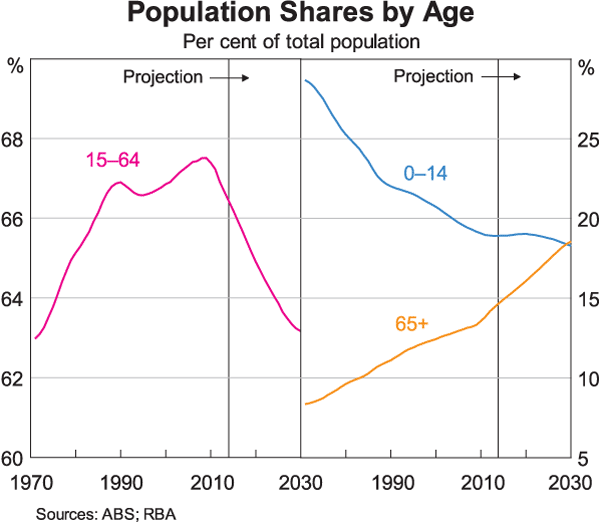A mixed bag of labour force fixes
The government proposed three policies to combat falling labour force participation in today’s budget. Unfortunately the results were a mixed bag and the participation rate is set to decline further during 2014-15. The government will have to do more if it wants to convince the Australian people it is serious about improving participation.
Over the past few decades Australia has experienced favourable demographics that have helped to boost growth. Until recently Australia had a relatively young population, flush with people at prime working age. The trend towards greater female participation in the work force also boosted growth significantly.

However, in recent years these favourable demographics have begun to reverse. The ‘baby boomers’ are beginning to retire and the share of the population aged 65 or over is set to rise to almost 20 per cent by 2030.
The ageing of Australia’s population has a range of implications but the most obvious has been felt in the labour market. The labour force participation rate has declined rapidly since 2011 and is currently near its lowest level in around eight years.

Participation is an important issue for government budgets. Revenue is generated by those that participate in the economy – income taxes on earnings, capital gains on investments and GST on spending. When people are unemployed or alternatively retired, the government loses valuable sources of tax revenue.
In its 2014-15 budget the government has outlined a variety of policies designed to boost participation. These policies are aimed at both the young and old.
The government has proposed forcing jobseekers up to 30 years of age to participate in job search and employment service activities for up to an additional six months before receiving Newstart or other youth allowance payments.
After six months, jobseekers under 30 will have to participate in work for the dole activities for at least 25 hours a week and will be eligible to receive income support for six months.
The rationale behind the policy is to stop young Australians from relying on welfare, forcing them to get up off the couch and enter the workforce. Unfortunately this rationale is completely at odds with the plight faced by young Australians.
The unemployment rate for 15 to 24 year olds has increased significantly since 2008, rising to around 12.5 per cent in March. But that severely understates the challenge facing today’s youth (Why rising youth unemployment demands our urgent attention, April 29; A steep bill for Australia’s lost youth, April 18).
Young Australians need more than tough love to improve their situation. A stronger economy and more opportunities will do far more to improve youth employment than withholding welfare payments. At best this is a measure that might have a positive effect on the margin but if the jobs don’t exist then young Australians simply can’t find them.
The government has also proposed the Restart program, with the government providing scope for around 32,000 mature-aged job seekers to re-enter the work force. This program provides employers with a subsidy of up to $10,000 if they hire an eligible mature-aged job seeker on a full-time basis (a reduced subsidy applies for those employed on a part-time basis).
Unlike the youth policy, the Restart policy could help boost participation among older Australians. Lose your job in your 50s and good luck finding a new one. Businesses are often incredibly reluctant to hire older workers, particularly if they require additional training. A small financial incentive may be enough to encourage employers to take a chance on our more than capable older work force.
Unfortunately the program is fairly small, with 32,000 a mere drop in the ocean compared to the 2.7 million Australians between the age of 55 and 64 years.
Finally, the government will proceed with its Paid Parental Leave scheme. It believes that it will encourage and assist women to remain connected to the workforce.
The unfortunate reality is that the scheme will do little to boost female participation in the labour force. The Productivity Commission found that a paid parental leave system that provides full replacement wages will have only an incremental effect on the labour supply.
A superior alternative to paid parental leave is childcare subsides. Research by both the International Monetary Fund and Organisation for Economic Co-operation and Development found that reducing the cost of childcare promotes female participation in the workforce – to a greater degree than paid parental leave and at a lower cost to boot. The IMF estimates that a 50 per cent reduction in childcare costs could boost participation by between 6.5 per cent to 10 per cent.
Labour force participation remains a significant challenge for the Australian economy. In this regard the budget is a mixed bag – with one small policy aimed at older Australians that may prove beneficial and two policies that will have, at best, a modest effect on participation.
These measures will do little to reverse youth unemployment and generous concessions for women will do nothing to lower the cost of child care when they eventually decide to re-enter the workforce. The government will have to do a lot better if it wants to convince the Australian public it is serious about employment.
















